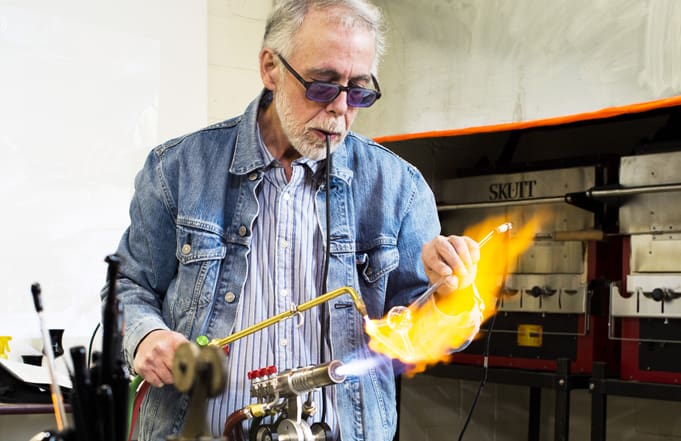March 23, 2018
On February 15, 2018, Michael Souza, an expert scientific glassblower at Princeton University, gave a public lecture and demonstration to the campus and community in the Emerick Art Studio which houses the University of Montana Western’s Glassblowing program.

At Princeton, Souza is the university’s only scientific glassblower and is widely recognized as the nation’s top expert in the field. He creates highly complex glassware and instrumentation that furthers scientific research for almost all research groups on campus, as well as contributing components for research projects conducted across the globe.
On Montana Western, Souza felt that the facilities for the glass courses were “an amazing place,” and that the Experience One program facilitates artistic and technical breakthroughs for students, which he felt “is what makes learning great.”
“Over the course of my first few days, the institution’s Block Scheduling Program impressed me. I liken it to a unique Graduate School experience, where students and instructors work in a focused partnership of discovery. It is this kind of learning experience that makes our upper universities the best in the world and why it attracts and produces their finest minds. However, to maintain this excellence, the reciprocal benefit of teaching and learning in this environment shouldn’t be reserved for just an upper tier of higher educational degrees. Instead, we should broaden it and this is why UMW’s remarkable ‘Experience One’ program is so important. I will always treasure the experience that was afforded me,” said Souza.
Souza crafts proof-of-concept pieces used to support new patents as well as vacuum manifolds and high-pressure cells used in optical-spin exchange experiments, including those made for high energy experiments at the Stanford Linear Accelerator.
“Since the early days of inquiry, glass has provided the medium for the observation and measurement of science,” said Souza.
He cited early scientists including Galileo’s use of the telescope in the early 1600’s, to J.J. Thomson’s discovery of electrons using cathode ray tubes in the early 1900’s all the way to the present-day research that is being conducted using his glass instruments.

Souza has created glass devices for research in the areas of electron acceleration, subatomic quarks, MRI systems for improving the imaging of complex organs, safer methods for landmine detection, improved guidance systems for satellites, and his work may be implemented in future methods in the detection of dark matter.
His blown glass instruments have also been used in research conducted at the South Pole in an attempt to answer some of our biggest questions.
“Does the universe have a direction? How did the universe begin?” he asked the audience. “Glass is being used in experiments to try to determine the very nature of our existence. The stars and planets we know about make up only 4% of the known universe, so there’s still a long way for us to go.”
One of the most exciting projects Souza is currently working on is the upcoming ICEMAG mission to one of Jupiter’s moons, Europa. According to the NASA/Jet Propulsion Laboratory website, “ICEMAG, for Interior Characterization of Europa using Magnetometry, will observe the magnetic field near Europa with greatly enhanced sensitivity compared to a similar instrument carried by NASA’s Galileo spacecraft, which orbited Jupiter from 1995 to 2003.”
Souza has created several glass “cells” that will be able to detect radiation on the unmanned craft using sodium iodide crystals. These measurements will be essential to understanding the nature of Europa, which scientists believe may contain a saltwater ocean underneath a thick layer of ice, and that ocean could potentially be considered a “habitable” environment.
The NASA/Jet Propulsion Laboratory website also explains the fascination with Europa. Galileo was the first scientist to publish his discovery of Europa in 1610. Hundreds of years later, the Galileo spacecraft “determined that Jupiter’s magnetic-field lines were bent in the space around Europa. This strongly implies that a special type of magnetic field is being created — or induced — within the icy moon by a deep layer of some electrically conductive fluid beneath the surface. Since Europa’s composition includes water ice, scientists determined the most likely explanation for the induced magnetic field is a global ocean of salty water. The magnetic field data from ICEMAG will take Galileo’s measurements to the next level.”
The ICEMAG Mission will head to Europa sometime in the 2020s.
For more information on Montana Western’s Glass Program, contact Associate Professor Michael Hengler by email at [email protected], or call 406-683-7344.